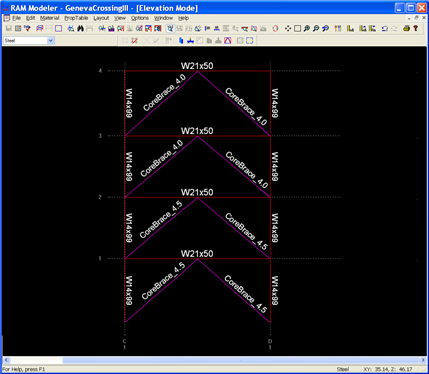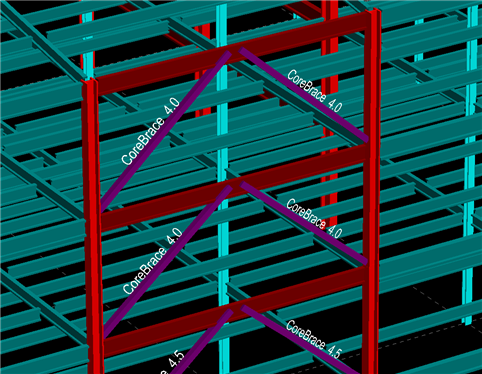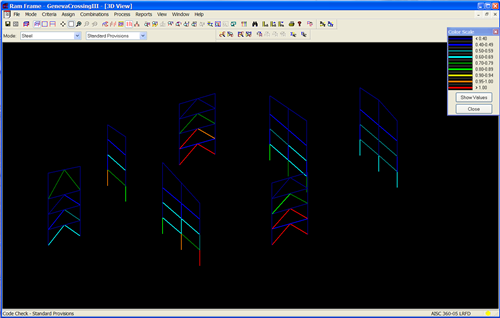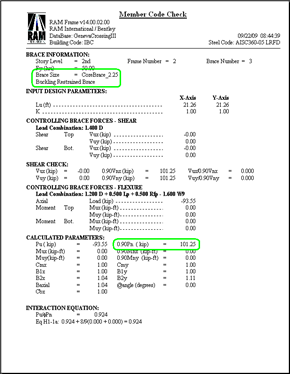Note: The methodology described in this article has been replaced with a more robust implementation of CoreBrace Buckling Restrained Braces. See the article: Specifying and Designing CoreBrace Buckling Restrained Braces in the Ram Structural System.
CoreBrace buckling restrained brace shapes are now available in the RAM Structural System. This feature allows the engineer to conveniently assign CoreBrace shapes to buckling restrained braces in the RAM model.
To model, analyze and design buckling restrained braces using CoreBrace shapes, do the following:
Select the CoreBrace Master Steel Table
A Master Steel table, COREBRACEAISC.TAB, is now available containing the CoreBrace brace shapes. This table is a duplicate of the RAMAISC.TAB table that contains all of the AISC shapes for beams, columns and braces, with the addition of the CoreBrace shapes. To select this Master Steel table select the Criteria - Master Steel Table command and select COREBRACEAISC from the list of tables. Note that this table can be edited and updated if necessary as explained in the RAM Manager manual.
Create the model, including braces
Create the model in the Modeler. Typically Fy for the braces is specified a value in the range of 38 to 46 ksi. CoreBrace can assist the engineer in determining the appropriate value to use.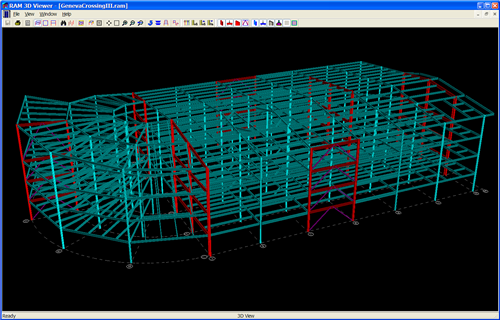
Assign sizes to the braces
Brace sizes can be assigned either with the Layout - Braces - Assign Size command in Elevation View in the Modeler or with the Assign - Braces - Size command in RAM Frame.
The CoreBrace shapes are listed under the Flat Bar shapes. Select the desired size from the list and assign it to the braces in the model.
In the 3D View CoreBraces are drawn as square braces, scaled to the size of the typical casing for that brace size. Contact CoreBrace for the exact size of the casing for the actual geometry.
Specify the braces as Buckling Restrained Braces
In RAM Frame use the Assign - Braces - Buckling Restrained command to specify the braces to be BRB's; at that time an Axial Stiffness Multiplier, as determined by the engineer, is assigned to each brace.

In the analysis performed by RAM Frame the braces lengths are based on centerline dimensions; the purpose of the Axial Stiffness Multiplier is to take into account the increased stiffness resulting from the true joint dimensions and the size of the connection. By increasing the brace stiffness with this Multiplier, a more realistic analysis is obtained. CoreBrace can assist the engineer in determining the appropriate values to use.
Analyze the model
In RAM Frame, analyze the model using the Process - Analyze command.
Perform a Code Check
In the RAM Frame - Steel Standard Provisions mode, select the desired steel design code (e.g., AISC 360-05 ASD or LRFD), generate the corresponding load combinations (either automatically or manually) and then perform a code check using the Process - Member Code Check command. A code-check is performed per the Standard provisions of the specified Code for the load combinations that have been generated.
With the View/Update command the user can select any brace of interest, view the results including the interaction equation, and can select and investigate other CoreBrace sizes.
If the currently assigned size is not acceptable, different sizes can be investigated, and when the desired CoreBrace size is determined, it can be saved back to the brace using the Update Database command. In this way the engineer can quickly arrive at the optimum sizes. Of course, if the Axial Stiffness Multiplier is different for the new brace size, the user would have to reassign that value.
The design results can be viewed:
Note that since it is a Buckling Restrained Brace, the axial capacity is based on the tensile capacity of the section, regardless of whether the brace is in tension or compression.
In addition to the standard provisions of the steel specification, there are additional seismic requirements per AISC 341, but those provisions are currently only checked for Star Seismic Buckling Restrained Braces. The engineer should perform these checks independently for CoreBrace Buckling Restrained Braces.



